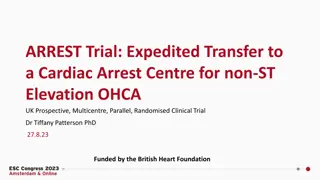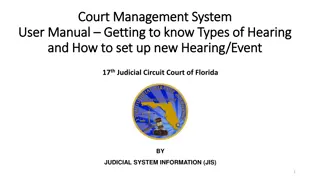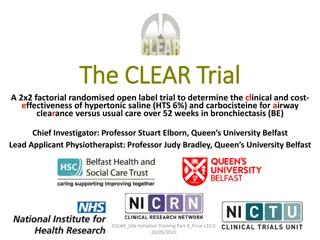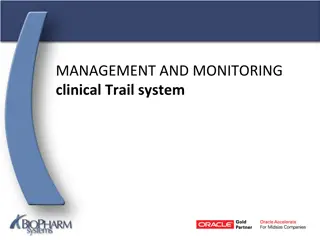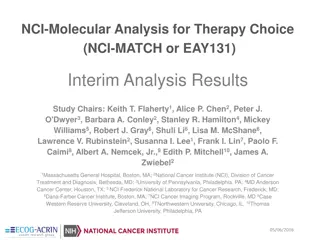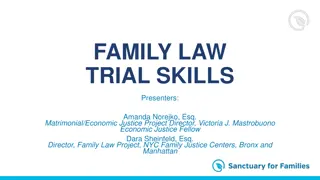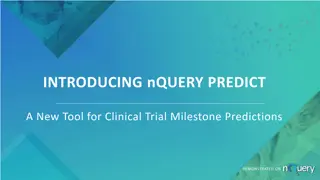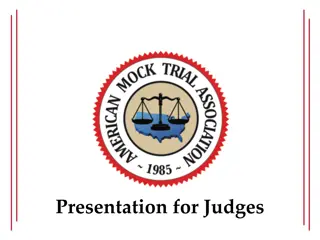Simulation Techniques in Clinical Trial Design
Explore the process of simulating clinical trial designs, including traditional and adaptive approaches. Learn how to generate data, conduct analysis, make within-trial decisions, and summarize results using fixed-sample two-arm parallel group trials and group-sequential designs. Dive into methods like t-testing and power analysis to enhance your understanding of clinical trial simulations.
Download Presentation

Please find below an Image/Link to download the presentation.
The content on the website is provided AS IS for your information and personal use only. It may not be sold, licensed, or shared on other websites without obtaining consent from the author.If you encounter any issues during the download, it is possible that the publisher has removed the file from their server.
You are allowed to download the files provided on this website for personal or commercial use, subject to the condition that they are used lawfully. All files are the property of their respective owners.
The content on the website is provided AS IS for your information and personal use only. It may not be sold, licensed, or shared on other websites without obtaining consent from the author.
E N D
Presentation Transcript
Simulating Clinical Trial Designs Prof Adrian Mander Cardiff University
We got to the chapter on simulating trials
Traditional and Adaptive Clinical Trial Simulator (tacts) I thought I would write my own simulator that needs How to generate data data() What is the analysis analysis() What are the within trial decisions decisions() Output and summarise the results output() 1. 2. 3. 4.
Fixed sample two-arm parallel group trial Set sample size Experimental group (1) ss(n=400) Data step Randomise Trial Population Generate x to be a 0 for half the people and 1 otherwise x~fixed(0.5,0.5) Control group (0) Generate y to be normally distributed with the mean 2.6 for those on the experimental arm and 0 otherwise y~N(2.6*x,8) data(x~fixed(0.5,0.5); y~N(2.6*x,8);)
Fixed sample two-arm parallel group trial Analysis step Experimental group (1) A t-test using a standard Stata command analysis(ttest y, by(x);) Output step Randomise Trial Population Generate a new variable called power that contains whether the p-value from the t-test is below 0.05 output(power = {r(p)}<0.05;) Control group (0)
Fixed sample two-arm parallel group trial Full command tacts, ss(n=400) data(x~fixed(0.5,0.5); y~N(2.6*x,8);) analysis(ttest y, by(x);) output(power={r(p)}<0.05;) nsims(10000) saving(results) replace seed(1) Experimental group (1) Randomise Trial Population Control group (0)
Group-sequential two-arm parallel group trial N=400 N=200 N=100 Exp arm Exp arm Exp arm Trial Pop Trial Pop Trial Pop Con arm Con arm Con arm Decide whether to continue? Decide whether to continue?
Group-sequential two-arm parallel group trial Set sample size ss(n=100 n=200 n=400) Data step Data are generated after passing each interim decision to continue data(x~fixed(0.5,0.5); y~N(2.6*x,8);) Analysis step Use a regression model analysis(reg y x;)
Group-sequential two-arm parallel group trial Decisions A design could be that the trial stops based on the Wald test statistic at each interim taken from the linear regression. The decision here is to stop the trial for a GO or Efficacy decision decision( ) n=100: stoptrialE if _b[x]/_se[x]> 2.5; n=200: stoptrialE if _b[x]/_se[x]> 2.2; n=400: stoptrialE if _b[x]/_se[x]> 2;
Group-sequential two-arm parallel group trial Output Capture the stopping criteria, Wald test statistics and estimate of slope at EACH stage and simulation output(stop = {stoptrialE}; ttest = _b[x]/_se[x]; slope=_b[x];) Summaries The power is whether the stopping criterion is met at any stage (including the final one) and the probability of stopping early (PET) is a positive result in the first two interims. outputsummary( Power=(stop1==1)+(stop2==1)+(stop3==1); PET=(stop1==1)+(stop2==1); ESS_H1 = 100*(stop1==1)+200*(stop2==1)*(stop1==0) +400*(stop1==0)*(stop2==0); Bias= cond(stop1==1,slope1-2.6,cond(stop2==1,slope2-2.6,slope3-2.6)); )
Sample size re-estimation two-arm parallel group trial In the situation of a continuous outcome the sample size calculation (n per arm) for superiority for a two-arm parallel group trial 22?2 ?1 ?/2+?1 ? n = 2 The variance in this calculation is assumed from external information (this is a risk in the trial design). Re-estimating the variance during a trial reduces this risk (can be done blinded or unblinded) Set sample size Maximum sample size chosen using an of the SD of 8, = 2.6,? = 0.05 and ? = 0.1 ss(n=199 n=398) Data step Data are generated after passing each interim decision to continue, note the smaller SD data(x~fixed(0.5,0.5); y~N(2.6*x,7);)
Sample size re-estimation two-arm parallel group trial Analysis step Use a regression model analysis( reg y x; local maxn = ceil(4*(invnorm(0.975)+invnorm(0.9))^2*(e(rmse)^2)/(2.6^2)); local SS=e(N); test x; ) Output Capture the stopping criteria, Wald test statistics and estimate of slope at EACH stage and simulation output(pv = {r(p)}; maxn= {maxn}; ss = {SS};)
Sample size re-estimation two-arm parallel group trial Decisions The decision here is to either re-estimate the sample size OR stop the trial for a GO or Efficacy decision decision( ) n=199: SSR local n2 = {maxn}; stoptrialE if {maxn}<=199; Summaries In our simulations the trial did not stop after the first interim so there is always an analysis at the end of the trial outputsummary(Power = pv2<0.05; maxn=maxn1; final_ss=ss2;)
Response adaptive randomization 4-arm parallel group trial We often design trials with a fixed allocation ratio throughout the trial, for example, the balanced design allocates equal numbers to each arm The response adaptive design alters the balance in favour of better performing treatments In this simple case at the interim calculate the p-value of each active arm versus control. Then the probability the active treatment i is given is 0.75*(1-pv1)/(3-pv1-pv2-pv3) the control probability is 0.25. Set sample size Maximum sample size chosen using an of the SD of 6, = 2.6,? = 0.0166 and ? = 0.1 and is 146 per arm, using a Bonferroni correction ss(n=200 n=584)
Response adaptive randomization 4-arm parallel group trial Data step Data are generated where treatment 3 is better than treatment 1 which is better than treatment 2 The allocation ratio starts as a 1:1:1:1 design (up to participant 200) setup(local p0 0.25; local p1 0.25; local p2 0.25; local p3 0.25;) data( x~fixed({p0},{p1},{p2},{p3}); x1=x==1; x2=x==2; x3=x==3; y~N(-1*x1-0.5*x2-2.6*x3, 6); )
Response adaptive randomization 4-arm parallel group trial Analysis and Output steps A linear regression, using the test command to obtain the p-values and the rest are counting numbers in each treatment group count if x1==0&x2==0&x3==0; local N0=r(N); ) output( n_x0={N0}; n_x1= {N1}; n_x2={N2}; n_x3={N3}; pv_x1={pv1}; pv_x2={pv2}; pv_x3={pv3};) analysis( reg y x1 x2 x3; test x1; test x2; test x3; count if x1==1; count if x2==1; count if x3==1; local pv1=r(p); local pv2=r(p); local pv3=r(p); local N1=r(N); local N2=r(N); local N3=r(N);
Response adaptive randomization 4-arm parallel group trial Decision step A linear regression, using the test command to obtain the p-values and the rest are counting numbers in each treatment group decision( n=200: RAR local p1 = 0.75*(1-{pv1})/(3-{pv1}-{pv2}-{pv3}); RAR local p2 = 0.75*(1-{pv2})/(3-{pv1}-{pv2}-{pv3}); RAR local p3 = 0.75*(1-{pv3})/(3-{pv1}-{pv2}-{pv3}); ) Output summary step outputsummary( Power1 = pv_x12<0.0166; Power2 = pv_x22<0.0166; Power3 = pv_x32<0.0166; Stage2_SS_0=n_x02; Stage2_SS_1=n_x12; Stage2_SS_2=n_x22; Stage2_SS_3=n_x32;)
MAMS designs
Conclusions Fixed sample size designs Group-sequential designs RAR designs MAMS designs Created a flexible command to handle many trial designs including: Crossover designs Longitudinal designs Other distributions not just normal (Bernoulli, Survival, Expontential, etc ) Can handle other designs Buy our book to find out how to do the other simulations (hopefully later this year)



